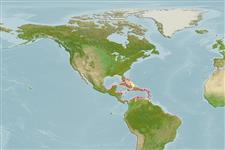Teleostei (teleosts) >
Gobiiformes (Gobies) >
Eleotridae (Bully sleepers)
Etymology: Gobiomorus: Latin, gobius = gudgeon + Greek, moros = silly, stupid (Ref. 45335).
More on author: Lacepède.
Environment: milieu / climate zone / depth range / distribution range
Ecology
Marine; freshwater; brackish; demersal; amphidromous (Ref. 46888). Tropical; 22°C - 29°C (Ref. 36880); 33°N - 5°S, 98°W - 35°W (Ref. 117424)
Western Central Atlantic: Southern Florida and southern Texas in USA to eastern Brazil. Eastern Central Atlantic: Macias Nguema (Fernando Po).
Size / Weight / Age
Maturity: Lm ? range ? - ? cm
Max length : 90.0 cm TL male/unsexed; (Ref. 11344); common length : 36.0 cm TL male/unsexed; (Ref. 12193); max. published weight: 7.5 kg (Ref. 11344)
Adults occur in fresh water, often well inland. Found over sand streams, usually in current near cover (Ref. 86798). Inhabits larger free flowing clear water streams (Ref. 11225). They lie mostly on the bottom in slower moving part of streams, sometimes on logs or large stones and on leaf debris or gravel (Ref. 11225). A carnivorous and benthic fish that relies on its sluggish behavior and cryptic coloration (Ref. 36880). Feeds on all greater invertebrates and regularly also fish (Ref. 92840).
Life cycle and mating behavior
Maturity | Reproduction | Spawning | Eggs | Fecundity | Larvae
Robins, C.R. and G.C. Ray, 1986. A field guide to Atlantic coast fishes of North America. Houghton Mifflin Company, Boston, U.S.A. 354 p. (Ref. 7251)
IUCN Red List Status (Ref. 130435: Version 2024-2)
Threat to humans
Harmless
Human uses
Fisheries: of potential interest
Tools
Special reports
Download XML
Internet sources
Estimates based on models
Preferred temperature (Ref.
123201): 26.4 - 28.3, mean 27.5 °C (based on 395 cells).
Phylogenetic diversity index (Ref.
82804): PD
50 = 0.6250 [Uniqueness, from 0.5 = low to 2.0 = high].
Bayesian length-weight: a=0.00851 (0.00434 - 0.01667), b=3.04 (2.86 - 3.22), in cm total length, based on LWR estimates for this species & (Sub)family-body (Ref.
93245).
Trophic level (Ref.
69278): 3.6 ±0.57 se; based on food items.
Resilience (Ref.
120179): Very Low, minimum population doubling time more than 14 years (Preliminary K or Fecundity.).
Fishing Vulnerability (Ref.
59153): High vulnerability (56 of 100).
